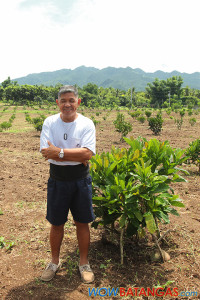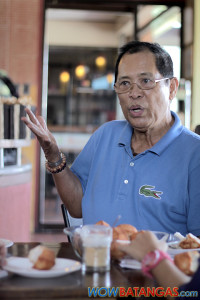Just when you thought the stories you’ve exchanged with your friends over cups of coffee are the only ones interesting, listen (or rather read on) and realize that coffee per se has its own stories to tell. Some may be trivial but most hold significant points in making you take another sip and this time, enjoy it to the fullest.
Coffee in Batangas: The Dawn of the Golden Years
In the coffee table book, “Peaks and Valleys: The Story of Lipa”, produced by the Lipa City Tourism Council, it was narrated there that a Franciscan friar brought the first coffee tree in Lipa in 1740, which was told to have originated from Mexico. Stories also tell that the Macasaet clan, who were the first settlers of Brgy. Pinagtong-ulan, were the ones to cultivate the first barako tree in town. This is the Liberica variety, unique because of its big coffee beans and strong taste and flavor when brewed.
How coffee trees were grown in huge numbers around the area were accounted to a couple of people. Captain Francisco Mantuano planted coffee trees in his backyard and distributed seedlings to other land owners while Augustinian priests, Frs. Elias Nebreda and Benito Baras, were the ones who promoted extensive cultivation of coffee. When Don Gallo De Los Reyes became gobernadorcillo in 1808, he enforced planting of coffee trees in every backyard in town. The efforts paid off and coffee plantations in Lipa continued to prosper.
Lipa became the fourth largest coffee producer in the world in 1880s, with production adequate to cover the shortage of coffee beans from Brazil, the top producer, which was then hit with coffee rust. This paved the way to a period of great prosperity for Lipa and the golden years of coffee in the country. Lipa was the first Coffee Capital of the Philippines.
Bean Talk
 Coffee that grows in the Philippines are Robusta, Arabica, Liberica, and Excelsa. Robusta trees grow in lowlands. It has small, round beans with weaker aroma and lesser taste than the other varieties. Known for its ‘earthy’ flavor, this variety is what instant coffee is made of.
Coffee that grows in the Philippines are Robusta, Arabica, Liberica, and Excelsa. Robusta trees grow in lowlands. It has small, round beans with weaker aroma and lesser taste than the other varieties. Known for its ‘earthy’ flavor, this variety is what instant coffee is made of.
Arabica grows well on highlands like the Mountain Province. The bean is a little larger than Robusta beans, more oval than round, and has lesser caffeine content than Robusta. They say it has the finest aroma and has smooth, nutty or citrusy flavor.
Liberica coffee can grow in a wider range of soil types. It has the largest coffee bean size and is asymmetrical, the other end is smaller than the other. It has a strong and pungent aroma that is floral and fruity and has a full and smoky flavor. Liberica coffee is associated with Batangueños’ trait of being ‘barako’ or ‘matapang’ because of its strong flavor and aroma.
Excelsa can survive hot temperature and is suitable in tropical lands. It is often mistaken as Liberica as their beans look almost the same. Excelsa coffee bean is shaped like an egg, only flattened. The flavor is mild and smooth, a bit earthy.
The Resurrection of the Glory
 The glorious years of Batangas Coffee came to a halt when the disease coffee leaf rust hit the plantations in the 1900s. Other factors — the war, cheaper coffee from elsewhere, general loss of interest in farming, ensured the downfall. In the aftermath, an immune-to-rust variety of coffee called Robusta, with smaller beans, was planted in the whole country. The barako and our identity were lost.
The glorious years of Batangas Coffee came to a halt when the disease coffee leaf rust hit the plantations in the 1900s. Other factors — the war, cheaper coffee from elsewhere, general loss of interest in farming, ensured the downfall. In the aftermath, an immune-to-rust variety of coffee called Robusta, with smaller beans, was planted in the whole country. The barako and our identity were lost.
This is one important motivation for Batangueños to revive the industry that hailed Batangas coffee back then. To bring back those glorious years may be colossal in the present time, because the dilemma lies in the number of people to cultivate coffee.
In the age of everything instant, who will wholeheartedly grow coffee in his backyard to supplement the shortage of production here in the province? If this coffee situation we have will be told in a movie plot, we’re lucky to have the heroes to save the day.
Barako coffee tree farming
 Retired Col. Nicetas Katigbak grew the obsession of bringing back kapeng barako to Lipa City. Because other regions are claiming that they produce this infamous coffee variety, Col. Katigbak is firm to say that it is only in his farm where good number of genuine kapeng barako trees grow.
Retired Col. Nicetas Katigbak grew the obsession of bringing back kapeng barako to Lipa City. Because other regions are claiming that they produce this infamous coffee variety, Col. Katigbak is firm to say that it is only in his farm where good number of genuine kapeng barako trees grow.
He started cultivating five years ago. After a tedious search of Liberica tree, Col. Katy (as he’s commonly called) found one in Brgy. Talisay and another one in Brgy. Sampaguita, both in Lipa City. The seedlings he purchased there are now the trees maturing in his farm in Brgy. Tipacan. More coffee trees are growing in his other farm in Brgy. Sto. Toribio.
He’s got high hopes for the resurrection of coffee production in Batangas, particularly in his hometown. An endeavor he started “…thinking na in the near future yung mga tao magtatanim din… gusto ko bawat bahay magtatanim din, tigli-lima,” said Col. Katy.
Because there is no other coffee farm like his in Batangas, Col. Katigbak began his mission by giving away or selling seedlings to others so more and more people will start planting, too. Those who received or purchased planting materials from him will be given the guarantee that Col. Katy will buy back the finest ones so he can grow more of high quality.
With the onset of Department of Education’s K-12 program, another door opened for Col. Katy to influence more people to cultivate coffee. Students from Grades 11 and 12 from various public schools in Lipa undergo lecture and skills training on coffee farming in the Lipa Coffee Academy. Col. Katy’s ‘sidekick’, Mario Anicete, takes over the class every week where coffee lessons brew in the minds of the young Lipeños. A classroom building was built on Katy’s Farm in Tipacan.
Kapeng barako beyond Batangas
Where do you usually buy ground barako coffee? Siete Baracos Coffee is the first, original Batangas brewed coffee in supermarkets since 1977. Through the efforts of Dr. Amado Silva and his family, kapeng barako reached places beyond Batangas. Distributed by Bayanan Delicacy Center, the Siete Baracos Coffee then came in commercial packs and had found its place on the racks of supermarkets in Metro Manila and Cebu.
In 1970s, Dr. Amado’s father cultivated his coffee farm in the barangays of Bayorbor and San Sebastian in Mataasnakahoy. Dr. Amado saw an opportunity for their coffee business to grow. He began roasting the baraco beans and put the coffee powder in a nice package which he then brought to Manila.
From tree to cup
 Another Lipeño contributing to the coffee industry in Batangas is Joe Mercado, a descendant of the Macasaet clan and the man behind Cafe de Lipa. He grew up breathing coffee, literally. From farming to producing coffee in drinking form, Sir Joe also shares the same belief on how our coffee industry can boom again.
Another Lipeño contributing to the coffee industry in Batangas is Joe Mercado, a descendant of the Macasaet clan and the man behind Cafe de Lipa. He grew up breathing coffee, literally. From farming to producing coffee in drinking form, Sir Joe also shares the same belief on how our coffee industry can boom again.
The factors that led to the downfall of Lipa’s coffee industry, according to Sir Joe, are land reform, industrialization, and lack of farmers. Farm lots were transformed into industrial parks and subdivisions; children of farmers sought for greener pastures in professional fields, not coffee fields.
Like Col. Katigbak, Sir Joe also see the need for the local government’s support to bring this mission of reviving the golden days of coffee in Batangas in full throttle, giving emphasis on turning more Batangueños into coffee farmers.
In their family’s thriving business, the Mercados bring the goodness of coffee “from tree to cup”. Carrying the barako label on most of their products, Cafe de Lipa creates a great recall between coffee or kapeng barako and Lipa. More than that, their goal is to make Cafe de Lipa synonymous to Filipino coffee, as they introduce other coffee varieties from other places in the Philippines but keeping kapeng barako close to their hearts.
To clear your thoughts, kapeng barako is Liberica coffee. Liberica coffee can be grown anywhere in the Philippines and not just in Batangas. Therefore, Liberica coffee that is cultivated in Cavite is still kapeng barako.
It’s just that Liberica coffee and the soil of Batangas fit perfectly together, like that perfect blend on a cup for a rainy Monday afternoon. Since this variety put Lipa, Batangas on the history of coffee in and out of the Philippines, we hope that Liberica or barako coffee will come back home.
The coffee industry and barako identity of Batangas will be revived and found only if we start drinking kapeng barako ourselves and create the demand to push coffee farmers to start growing again. This will involve a huge information campaign and a necessary culture change, and will require collaboration between the farmers, the local and provincial government, and us barakos.
SOURCES
• The Grandeur that was Lipa, blog by Renz Marion D. Katigbak
• Peaks and Valleys: The Story of Lipa, coffee table book by Lipa City Tourism Council
• newsinfo.inquirer.net
• Demythologizing the History of Coffee in Lipa in the 19th Century, dissertation paper by Ma. Rita Isabel S. Castro
 WOWBatangas.com Your Source of Great News and Stories from the Province of Batangas, Philippines
WOWBatangas.com Your Source of Great News and Stories from the Province of Batangas, Philippines





Nice post. Your article will awaken farmers’ interests to get into coffee farming. Im planning to raise libereca coffee in my farm in mindoro having an area of more than 10 hectares. Im wondering if i can get enough seedlings to plant. Also thinking of the first step that i should fo to check if my farm is indeed suitable for liberica coffee production. Any suggestion please.
Please send my congratulations and greetings to Col. Katy.